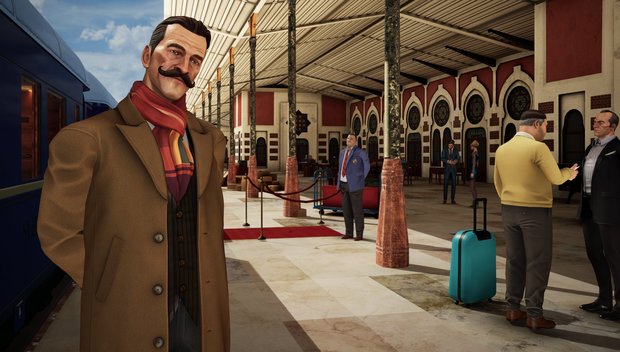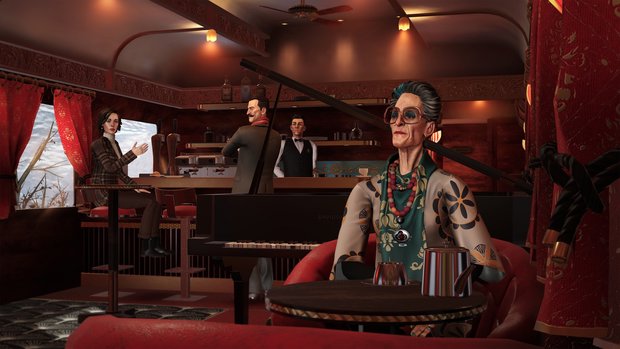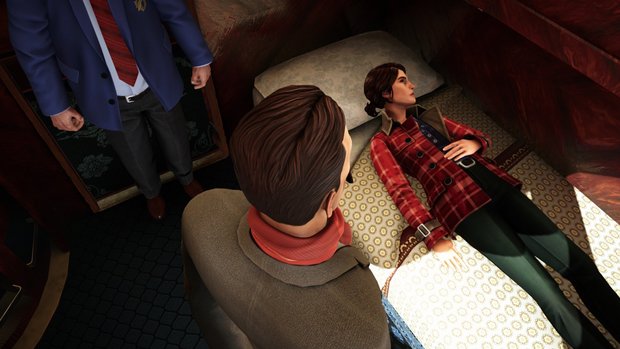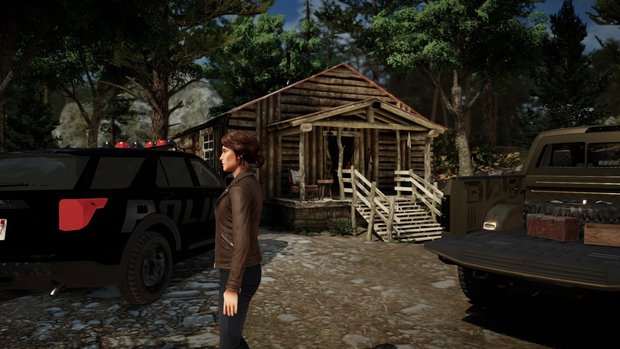Agatha Christie: Murder on the Orient Express review

- 0 Comments
Fresh take on a classic whodunit makes for a breezy, enjoyable ride
Microids Studio Lyon brings the most famous Belgian detective, Hercule Poirot, into the 21st century – cell phones and all! – with a re-imagining of what is probably his most well-known case, Murder on the Orient Express. Even though I’m Belgian myself, and should have thoroughly delved into this particular cultural heritage by now, I’ve only read a handful of Agatha Christie’s Poirot stories in my life, and surprisingly not this one. I did see the Kenneth Branagh movie adaptation, however, so I did have a notion of the story and its conclusion. But when I finally do read the novel, I’m sure I’ll be constantly picturing this game in my mind’s eye, as it charmed me with its visually detailed 3D world, eclectic characters, orchestral jazzy soundtrack, fun little mini-games, and of course the deduction processes. And for those who are all-too-familiar with Christie's intricate mystery at this point, the game expands on the Queen of Crime's original to bring a brand new playable character and a couple of extra puzzle-filled chapters.
The story starts – not in the 1930s like in the original, but in 2023, bringing it into modern times – with Hercule Poirot walking in all his splendor into the Tokatlian Hotel in Istanbul to meet with his old friend Bouc, who has promised him a place on the legendary train back home during its 140th anniversary trip. The character design of Poirot makes him look like an even more dashing version of Branagh’s portrayal instead of a David Suchet type better fitting the books’ descriptions. Perhaps Microids figured out that we Belgians can be quite handsome devils.
You can walk around freely in this semi-open 3D game world; only “semi” because the limited locations are clearly defined in each chapter. Many doors will stay locked in one chapter, only to open up in the next, and there are even some invisible walls here and there. There’s no reasoning behind this other than effectively limiting the active search area. It’s not realistic, but it makes the game easier and much more user-friendly. On PC you maneuver through the train cars and other settings using WASD or directional keys. The mouse controls the camera, and you can manipulate hotspots with either a click of the mouse or a designated keystroke. There’s also full controller support.

The environments themselves are so rich in detail that there’s plenty to look at in the spaces available. The game perfectly captures the romantic idea and adventure-inspiring setting of the Orient Express with its fourteen sleeping cabins, the lounge bar, restaurant, the kitchen, storage compartments, and even a couple of water closets. While backtracking often feels irritating in adventure games, here it’s a pleasure to move back and forth through the train and soak in that beautiful Belle Époque style. The howling wind and the sounds of the train moving along the tracks make for immersive ambience, and the journey is brought even more to life by an orchestral soundtrack, sometimes a bit jazzy, with great solos for piano, trumpet and sax (the latter also a Belgian invention, by the way!).
But before you board the Express, another hotel guest interrupts jolly Bouc to report his train ticket stolen. Bouc immediately volunteers Poirot to solve the case, and after a short interrogation you join the guest in the elevator to his room. During the ride up, the game checks if you’ve been paying attention so far. Poirot decides to test his powers of observation, and you’ll get a couple of multiple choice questions about the guest’s appearance.
Immediately this introductory chapter gets you acquainted not only with the investigative gameplay, but also with the necessity to keep your ears open and eyes peeled at all times. The correct answers to the character questions are details you’ve either noticed on this person yourself – some physical trait or an accent in their speech indicating a possible nationality – or what you overheard or they have told you personally earlier. This element of the gameplay is very enjoyable, because it forces you to really imagine yourself observing this fictional world like an investigator. It’s fun keeping an eye on all the little details as if you were truly a detective, since you never know when you’ll need to know something.
You’ll have to do this often during the course of the game, but it’s easy enough that you should be able to get it right on the first try. If you do get something wrong, the screen will glow red briefly, Poirot will mention this and you can simply try another answer from the list. In the end, even if you have to resort to trial and error all the way through, you’ll always wind up with the right solution. And you’ll need to, as the game will stay there, preventing you from continuing until you get it right.

The second I walked into the unfortunate guest’s hotel room, I deduced what had happened by what I saw at first glance, without even having to take a closer look at the available hotspots. It was no doubt designed that way to ease players in, but I enjoyed seeing my initial hunches confirmed after guiding Poirot through all the evidence, making the necessary connections in his mind map, and slowly seeing all the puzzle pieces fall together. For a moment there I thought I might make a great detective in real life as well! This introductory mystery is a perfect prelude to the greater one that follows, where you often have no idea what happened until you do all the necessary investigation.
Of course, things only really start to get interesting once the titular homicide has occurred. A snowstorm holds the train and its passengers captive, the murderer still trapped on board with Poirot. In addition to the staff, there are thirteen passengers who all had the opportunity to commit the murder, all from different layers of society: a colonel, a Russian princess, a count and countess, a doctor, a businessman, a nurse, a secretary, a valet, and more, each with their own stories and secrets. They can all be recognized from afar by their distinct outfits, but they’re written as realistic people instead of caricatures. They’re all fully voiced, with fitting foreign accents where needed, without sounding too over the top. As Poirot, it’s your job to find out who among this eclectic group is in any way connected to the murder victim, and if they have alibis. You get to snoop around their cabins, interrogate them, and confront them when you have found contradictory information.
Not only do you get to control Poirot, however, the writers have embellished on the original Murder on the Orient Express by adding an extra protagonist in the form of the beautiful Joanna Locke. At the start of the game she hides in the corners, though of course not out of Poirot’s notice. Once discovered as an extra passenger on board, she jumps to the forefront. About half of the chapters are played from her perspective in flashback form, actively showing the story behind the motive of the murder on the train.
The gameplay from Joanna’s perspective is pretty much the same as when you’re controlling Poirot, only here you’re performing an ongoing police investigation that’s put her on the trail of a passenger on the Express. Her sections take place mostly in an expensive-looking mansion, though not one as richly detailed as the train. The house has many doors but only two are truly accessible. Eventually you end up at a mysterious cabin in the woods, which is better presented visually than the mansion.

When playing as Poirot, he first devises a course of action to tackle a particular problem in his mind map. These are your immediate objectives, so the mind map works as a kind of task list. After you’ve completed these individual goals, you have to connect all discovered clues with each other to figure out what happened (e.g. combine “open window” with “papers on the floor” to deduce the wind blew the documents off the desk). Lastly, you have to order all these elements into a timeline.
Several mini-games use the same technique. They don’t add to the plot of Murder on the Orient Express, but they are good for some brain training. For instance, Bouc persuades you to get your hands on the recipe of a yummy dessert served in the restaurant car of the Express. First you examine the dessert itself to identify some ingredients. Then you interrogate the chef, who will lie about the recipe, and you will have to refute her statements by what you observed earlier. Then you have to put all steps of the recipe in the right order following the directions of a logic puzzle (e.g. this step comes first or last, this step comes before that step, etc.).
Of course, most of the mind map deduction does involve the murder. But even with these, the game is extremely forgiving if you get something wrong. In fact, ultimately you can’t get anything wrong, because as with the character profiles, you can keep trying until you end up with the right answers. This even extends to the dialogues with other characters. During an interrogation, it’s possible to pick the incorrect reply, but it won’t have any consequences. Poirot will make a general remark to himself (“No, that’s not right.”) and you can simply go for another option. There are no alternative endings for choosing the wrong solution, and you move through the story in a very linear way.
You’ll find clues by looking out for hotspots, which are indicated by white dots hovering over objects. When you get close enough to interact with them, a white circle appears around the dots. Hit the interact button and Poirot will give his remarks, or when it comes to documents or items you can pick up, you’ll get a full-screen close-up so you can investigate further. When you are completely done with a particular hotspot, that white dot will helpfully turn into a gray icon, indicating it’s not necessary to revisit it.

All evidence you find is automatically added to the mind map, which you can access any time to look at either the clues or your tasks. The course of your investigation is also laid out here in various branching steps, with lines connecting related objectives, showing which clue or piece of information leads to which new question and ultimately to a deductive puzzle to be solved. Along with the mind map, the menu features an overview of all the characters you meet, and your inventory. You will gather notes and photographs during your investigation, containing information you will need to solve certain puzzles, though I found it handier to copy all the numbers I encountered into my own real-world notebook for easier referencing.
Many hotspots feature some logic puzzle or other. To name a few examples: you have to fix the gears in a machine, weigh unlabeled bottles on a scale to figure out which is which, complete a version of the Tower of Hanoi involving boxes of dinner ingredients, and there’s even a sort of Chinese puzzle box. In many games these kinds of logic or mechanical puzzles can be quite annoying, but in Murder on the Orient Express they are excellently woven into the narrative and fit the character profiles. And none will frustrate you to the point of giving up, since their difficulty level usually isn’t very hard. Only one puzzle ever stumped me, involving the opening of a matryoshka doll. Thankfully you can always ask for in-game hints, but in this particular case, even when I saw the solution in front of me, I still didn’t see the logic behind it.
If you happen to be a seasoned puzzler and feel you’re breezing through the game and want to prolong the experience, there are collectibles to be discovered in the form of solid golden mustaches, Poirot’s signature physical trait. There is always an indication of how many are hidden in any particular chapter, but because Murder on the Orient Express constantly holds your hand and tells you pretty much exactly what to do and where to go, it’s very easy to forget about these hidden collectibles. There’s a reason this whodunit is such an enduring classic, and here it truly pulls you in throughout the game. After a while I was so hooked by the investigation and the interaction with all those interesting characters that I stopped concerning myself with searching for the mustaches.
The game not only saves automatically but allows you to manually do so as well. However, since you can’t really do anything wrong, the only reason I can see to reload is to go hunting for those collectibles you might’ve missed. If you forget something, you should be able to find all the information in your mind map, but you can also re-examine all hotspots and even ask any characters present in the current chapter all the same questions again.
As an added bonus, once the murder has been solved, the game doesn’t end where the book does. You get a couple of extra chapters presenting yet another layer to the story, where you’ll get to alternate control of both Poirot and Joanna at will. They take you to locations outside of the train, like an apartment, an office, and Venice with its labyrinthine streets, alleys and canals. These are connected fairly well narratively with the original tale but don’t feel like a murder investigation anymore. They contain more random escape room-type puzzles to find keys and lock combinations, as well as one rather difficult arcade-style chase sequence. The former are fun and even ingenious, but I had to redo the chase several times, which pulled me out of the story completely. At least it starts over from a spot right before you took a wrong turn if the suspect gets away, not all the way from the beginning. The fun part about these chapters is the dynamic between Poirot and Joanna, having them actually team up and work together, even when they have to split up and inform each other of their discoveries by phone.
Speaking of newer technologies, these extra chapters make better use of the fact that the story has been transported into modern times. Other than Poirot taking photos of the evidence he finds aboard the Express with his phone, the anniversary theme allows for a realistic recreation of the train in its earlier times, making it feel like you're almost a century in the past. The flashback and final chapters feel very much like a contemporary police investigation game with their modernized settings, in which you have to check phone records, uncover computer passwords, unlock electric locks and even defuse an intricate bomb at one point!
Final Verdict
It took me 14 hours to complete Murder on the Orient Express, and I had lots of fun questioning all the suspects on the train and solving the occasional logic or mechanical puzzle as Hercule Poirot, as well as getting to investigate the story behind the motive as police detective Joanna Locke. While the game offers perhaps too much guidance on where to go and what to do, making it a very linear experience without any alternative outcomes based on your decisions, it’s awesome to live through one of the best works in literary fiction in this interactive way. The Orient Express becomes your home for a while, its occupants almost a family – if a rather dysfunctional one – as you immerse yourself in discovering every clue and fitting all the puzzle pieces together. Even if you can’t really fail, earning that approving nod from Poirot or Locke when you’ve made a correct deduction filled me with pride and a feeling of accomplishment, and the entire experience made me wish there were more games of this quality out there.
Hot take
It certainly doesn’t take a great detective to solve this rather easy adaptation of Murder on the Orient Express, but there’s just something about stepping into the shoes of Hercule Poirot to snoop around the most beautiful and famous train in history in an intricately plotted whodunit that makes it immensely satisfying. If you like playing detective, this interactive version of the most famous case in literary fiction will certainly tickle your own little grey cells.
Pros
- Many different deduction mini-games
- Intuitive mind map system to process clues and suspects
- Nicely integrated variety of not-too-hard logic and mechanical puzzles
- Ambient sound and jazzy orchestral music liven up the detailed scenery even more
- Retains all Christie’s key plot elements and character traits but adds additional content for those already familiar with the story
Cons
- Might be too easy for experienced adventure game aficionados
- Limited location accessibility lacks realism
Johnny played Agatha Christie – Murder on the Orient Express on PC using a review code provided by the game's publisher.










0 Comments
Want to join the discussion? Leave a comment as guest, sign in or register in our forums.
Leave a comment